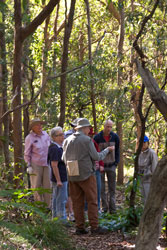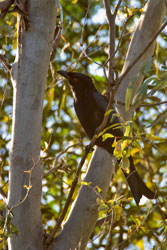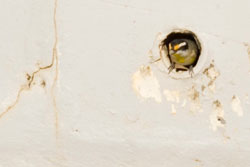rampant native vine has
reduced the observable bird
species in a section of Grange
Forest Park on 6 June 2010
Links to Home and to other years
General details of 2010 observations
Detailed results for 2010
Summary of results of past walks
Contact
Background
Since 2008, at least ten bird walks have been conducted each year in locations selected as being representative of bird habitats along Kedron Brook. This project aims to accumulate data on bird life along the Brook; specifically those variations in birds species noted together with their distribution.
To useful links and results from other years
Details of 2010 observations
Details of the locations and general arrangements for each walk are available in the yearly programs. Link to the 2010 Program here.
Grindstead Park and Sparkes Hill Reserve - 14 February 2010
The first sightings originally planned for Sunday 7 February had to be re-scheduled to 14 February due to heavy rainfall. The morning of the 14th at Grinstead Park was sunny though the previous rains had produced a strong water flow along the Brook. Leader Dawn Muir, assisted by Esther Townsend, together with six other birders enjoyed the morning sunshine and came up with a total of forty-three species of birds observed. The diversity of habitats in this area was an important factor contributing to the number of interesting observations enjoyed. The rare finding of an Australasian Bittern was unexpected for our region. Sighted on a dead branch of a tree, the bird was dive-bombed by Noisy Miners supported by Magpie-larks and a single Sulphur-crested Cockatoo. A Grey Goshawk stalking from a Eucalypt near the bat colony was given a similar turnaway by the Noisy Miners.
Bellbird Grove- 14 March 2010
Bellbird Grove on was sunny and a most pleasant morning for our group of four. We first dodged a quartet of German Shepherd dogs on their regular parkland walk. We only observed 32 species of birds; the morning being a light-on for the smaller birds.
Pony Club Bend and Teralba Park - 11 April 2010
On this morning, a very heavy fog lay across Brisbane. When we first arrived at Pony Club Bend, we had some doubts about the number of birds we would see in such conditions. However, we persisted and were joined by Dawn Muir, Ian Ferrier, Helen Moriarty, Harold Charles and our granddaughter, Madison. Although there were fewer smaller birds visible, we were rewarded by the sight of a Stirated Pardalote and observed a total of thirty-one species.
Wahminda Park and Maureen Lawrence Park - 9 May 2010
It was a chilly morning in bright sunshine as we set off to Wahminda Park at 7:30 am, 9 May (Yes! Mothers Day). Charles and Jenny Ivin were joined by Esther Townsend and Anne Ellerman for the survey. It was good to have Anne with us as she is a regular volunteer at Wahminda and was able to show us some locations where she has had good sightings. Although it was a bright morning, the chill in the air seemed to keep the smaller birds in their ‘beds’. We did have a very special sighting of a female Rose Robin which was the first we've seen at the location.
Cassimarty Park, Crane Reserve Wetland and Arbor Park - 9 May 2010
We had another sighting being carried out by Dawn Muir coincident with the Wahminda Park walk on 9 May. Only twenty seven species were observed by Dawn, no doubt the result of much damage caused by flooding earlier this year along Cedar Creek and Kedron Brook in this area. Significant erosion and fast flowing water had removed a great deal of past grasses and low weeds such as lantana along the creek banks. Arbor Park had also had much of the guinea grass and lantana removed by BCC staff as part of the regeneration of the remnant native forest. This would have diminished the natural habitat for a number of smaller birds observed on past sightings.
Grange Forest Park - 6 June 2010
This morning, Dawn Muir led six other participants through Grange Forest Park. We started at the entrance from Mornington St. on the circuitous walk to the Brook and then down the brook to the bikeway bridge, around to Raymont Street and back to the start through Alderley Grove. It was a sunny morning under good birding conditions though the end tally of only 30 species was way down on past walks. In contrast, the range of types of bird habitats noted over this walk was quite large. However, the long section from Raymont Street through a native vine covered section was virtually dead due to the lack of suitable feeding and cover for birds. crows and noisy miners were the exception. An unidentified raptor was spotted elsewhere and may have contributed to the relative decrease of species noted.
Kalinga Park, Cresey St. Wetlands and Benelong Park - 4 July 2010
It was fine at Kalinga Park and remained quite a cool morning through to the end of the walk in Benelong Park. We noticed four Bush Stone-curlews on the tree-covered hill above the children's playground area in Kalinga Park. They were still there when we returned at the end of our walk, but had moved deeper into cover. Several Straw-necked Ibis were seen, including some with pale uncoloured neck feathers. Twenty-seven Masked Lapwings were observed in Shaw Park, and it was here we later saw the huge flock of mostly Little Corellas. Two Long Billed Corellas were clearly visible amongst the flock. We observed a very determined Noisy Miner chasing a Striated Pardalote from tree to tree. The Keith Boden Wetland (Cressy Street) was looking under stress with many of the water birds being fed by locals. We saw bread and wild bird-mix being used by local families to feed them.
Cassimarty Park, Crane Reserve Wetland and Arbor Park - 1 August 2010
It was a fine though cool morning when we met at Cassimarty Park. Leader Dawn Muir and four other birders headed off first to Crane Park and were rewarded on the way with a sighting of a pair of Australian Wood Ducks with five young in the water. In Crane Park, we saw a pair of Australian King Parrots and some Musk Lorikeets. On the way back we saw the Wood Ducks and young still in the park. Interestingly, the adults assumed a very still, almost horizontal position on the grass as a walker with dogs on lead went past. The young were gathered closely by the female. It was exciting to see some Striated Pardalotes nesting in drainage holes inserted on the outside of a concrete culvert. Also of interest was the sighting of a small colony of flying foxes in tall trees beside the golf course towards Brook Park. Superb and Red-backed Wrens were lively in Arbor Park and a flock of Topknot Pigeons flew high overhead in an easterly direction above the Brook.
Cedar Creek - 5 September 2010
Leader Esther Townsend and two other participants carried out observations along Cedar Creek, near Kirralee Court, Upper Kedron and a small new housing development downstream from the Upper Kedron Road bridge. And so we trudged through wet grass and along paths, under threatening overcast conditions that weren't really conducive for birding. To our surprise, fifty different species had been observed by the end of a rainless walk; only the second time over our three years of birding that this number had been equaled. This success was mainly due to the diversity of the habitats available within this section of Cedar Creek but also to the keen eye and experience of our leader, Esther Townsend. The relevant bird list in the table below details the marvelous variety of bird types seen and enjoyed by our small group of birders.
Zion Hill Bushcare area and Albert Bishop Park - 3 October 2010
After another four weeks of indifferent, often rainy, weather, Leader Dawn Muir and three other participants started early at the Nundah Cemetery. This is normally followed by a stroll through the Zion Hill Bushcare Group's area and then down about a kilometre or so along the floodway before we all drive in our cars across to the Nudgee lake (at UBD Map 121 ref D20). However, there were very poor birding conditions with overcast sky with occasional drizzle at first but building up over the hour of observations to continuous rain. The cemetery is surrounded by a relatively dense bushland including a stand of Melaleuca, (Melaleuca quinquenervia), one of the last in the Kedron Brook catchment. Despite this rain, twenty-eight species of birds were observed over the hour. They were consistent with the results of past birding of this area, though obviously not of the Nundah lake or floodway that was not visited.
Nudgee Waterhole Reserve and Kedron Brook Floodway to Nudgee Beach - 7 November 2010
Five regular birders met at the Nudgee Waterhole at 7 am and were pleased to welcome newcomers, Pamela Farmer, Marilyn O’Sullivan and Helen Underwood. After we covered the circuit track around the waterhole, we drove by car and stopped to observe more birds including a Sacred Kingfisher near at the boat ramp along the Kedron Brook Floodway. Then, at the end of Nudgee Beach Road, we dodged the lapping waves between the mangroves and the sea around the beach front. This brought us to the outfall of the brook into Moreton Bay where another Sacred Kingfisher was found. With a total of forty-nine species observed, this was a very good count and of particular interest was the number of Dollar Birds and Rainbow Bee-eaters. Water birds and waders were scarce due in part to the extremely high king tide we experienced on the day.
Detailed results
The following table provides links to the results of any completed studies.
| Date | LInk to | Description |
|---|---|---|
| 14/02/2010 | 13 KB pdf file | Grinstead Park and Sparkes Hill |
| 07/03/2010 | 12 KB pdf file | Bellbird Grove/Brisbane Forest Park |
| 11/04/2010 | 12 KB pdf file | Pony Club Bend, Teralba Park, Brookside |
| 09/05/2010 | 13 KB pdf file | Wahminda Park & Maureen Lawrence Park, Samford Rd |
| 09/05/2010 | 12 KB pdf file | Cassimarty Park, Arbor Park, Brook Park (Not in program - special opportunity) |
| 06/06/2010 | 11 KB pdf file | Grange Forest Park |
| 04/07/2010 | 55 KB pdf file | Kalinga Park to Cressy St. Wetlands, Benelong Park, Mercer Park |
| 01/08/2010 | 12 KB pdf file | Cassimarty Park, Arbor Park, Brook Park |
| 05/09/2010 | 13 KB pdf file | Cedar Creek, Upper Kedron |
| 03/10/2010 | 12 KB pdf file | Nundah Cemetery only ( Zion Hill, parts of Albert Bishop Park, Nundah Lake missed due to rain) |
| 07/11/2010 | 13 KB pdf file | Nudgee Waterhole Reserve, Kedron Brook Floodway to Nudgee Beach |
Summary of 2010 observations
Details of all the studies for 2008, 2009 and 2010 are given in the table, 'Table 1 KBCB_WPSQ Results of Bird Studies 2008 - 2010, Summary of study dates, location codes, actual locations and conditions'. This is a small pdf file. Each study location code consists of an acronym of the location name together with a four numeral bit that represents the month and year. Thus, the code, 'FG-AP-BCP-0810', represents Ferny Grove, Arbor and Bob Cassimaty Parks specifically as conducted in August 2010.
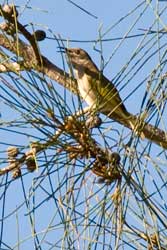
in the sunshine
A statistical analysis of all of the 2010 bird observations was carried out in a similar manner to that conducted for 2008 and 2009 using Microsoft Excel worksheets and suitable pivot table analysis to obtain summary information about the surveys.
The bottom section of Table 1 contains the 2010 location codes to assist the interpretation of the next table entitled, 'Table 4 - Common name of bird species as found at given coded locations surveyed in 2010'. A numeral '1' in the column below any given location code indicates that at least one bird of the species named for that row was observed for that location. For example, the fifth column with the 'FG-AP-BCP-0810' location code represents the Ferny Grove surveys conducted in August 2010. The top two rows down for that particular column indicate that there weren't any Australasian Bitterns or Grebes observed but the next two rows indicate that the Australian Brush-turkey and Figbird were observed for that survey, and so on.
In the third column, the location code differs only in the last four digits from that in the fourth column. This indicates the same location at Ferny Grove was surveyed in May as well as in August 2010. At the bottom of page 3 for this table, the grand totals indicate the total number of species observed for the May survey were only 27 compared with the 43 observed on the August survey.
Over the three years of bird studies, the number of bird species observed varied from only 11 up to 50 per outing depending upon the overall timing, month and variety of habitat at the location. Overall, we observed 123, 90 and 107 different bird species respectively over the 2008, 2009 and 2010 walks conducted. Taken over the first two years, we actually observed 138 different species, a consequence of the fact that not all bird species were observed in both periods. Now, after three years of observations, we have observed a total of 150 different species at some time over the three years along the Brook. But we’ll need many more years of study records before we can confidently determine any significant trends from our data.
Chart 1, entitled,'Number of birding walks when specified species were observed out of total of eleven conducted in 2010' shows the number of surveys out of the maximum of eleven surveys that particular species of bird were observed in 2010. A high zoom factor of about 200% is necessary to actually read the common names of these birds in this chart but the true value of this chart is in the variability in their observations over the year. It is obvious that there are common birds very settled along the catchment and others that might just find it suitable at odd times of the year, and others that have been forced over by odd climatic conditons from their normal areas, and even escapees such as the single Eastern Rosella observed.
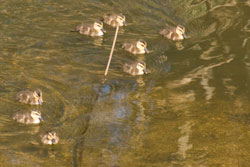
at Pony Club Bend, Mitchelton
As expected, the most common birds are the Australian Magpie, Laughing Kookaburra, Magpie-lark, Noisy Miner, Pacific Black Duck, Pied Butcherbird, Rainbow Lorikeet, Spotted Dove, Striated Pardalote, Sulphur-Crested Cockatoo, Torresian Crow and Willie Wagtail. (No necessarily in that order!)
Bird species that were only observed on one walk over the three years were many but the most “exciting finds” were probably the Australasian Bittern, Black-shouldered Kite, Brown Gerygone, Grey Goshawk, Large-billed Scrubwren, Northern Mallard, Pale-vented Bush-hen, Red-tailed Black-Cockatoo and a Square-tailed Kite. Our web site has tables of our full sightings that are best linked from the individual news items for each year or you can surf via our ‘Google search’ facility from any web page.
This is a result of the variability of the factors affecting bird biodiversity and suitability of bird habitats as conditioned by the season, weather, the influence of migratory requirements of certain species and even the time of day in each survey.
It is clear that this type of 'walk-through' survey needs to be conducted over at least five to ten years for a sound conclusion about the types of birds that do frequent our catchment and much longer to indicate any trends in the number of species present. The continuing decrease in available habitat to meet the special needs of particular species makes it unlikely that any continuing surveys will magically be found to be prove urban development processes may be beneficial.
Contact
Factors such as weather and availability of leadership mean that some outings may need to be changed at relatively short notice. Please contact Outing Coordinator, Jenny Ivin, on phone 3851 0160 or for further information.
CI 13/12/2015

